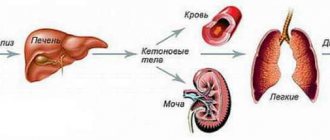In this article we will figure out how to open the head of the penis.
Most mothers carefully monitor the hygiene of their sons from a very young age. However, not everyone fully understands all the anatomical features of the structure of the child’s reproductive system. Many people wonder whether it is normal for the head of the penis to be open/closed. This question is due to the often obvious differences between a boy and an adult man. Experts find it difficult to answer this question, since the process is purely individual.

When does the head of a boy's penis open?
From the moment of birth, the boy’s foreskin is connected to the head of the penis with special adhesions. These connections prevent the head from opening partially or completely. This condition is called physiological phimosis by doctors. How the head should open depends on the age of the future man, since this type of phimosis is self-limiting. Over time, a systematic separation of the foreskin from the head of the penis occurs, which gradually leads to full opening. It is quite difficult to accurately formulate age restrictions for this process.
At what age do boys develop a head?
In infants, the head almost never opens, properly protecting the penis from various infections. There are two reasons why the head is not completely exposed at an early age:
- The birth of children with a foreskin that is in an oblong state.
- An opening in the glans that is not wide enough. The pathology of the foreskin, which has a narrowed nature, has a medical name - phimosis.
If phimosis in a child’s body is harmless to health, does not cause pain and does not interfere with the exit of urine from the urethra, then there is no reason for parental panic. But if this disease is no longer of a physiological nature and continues after 15 years, then this is already a dangerous phenomenon.
There are an unlimited number of opinions on this issue, but in this article we will focus on the points of view of qualified specialists. At the stages of the first 6 months in newborns, opening of the head in a natural way is quite rare in medical practice, but still real.
In most cases, the head opens in boys by age three or four. However, if this does not happen, then it should not be done artificially. These actions pose a threat of circulatory disorders and the appearance of an irreversible cessation of the vital activity of cells caused by the influence of pathogenic microorganisms.
It is worth remembering that the process of becoming completely naked is strictly individual. A child can get rid of natural phimosis in one year, and at 6 years, and at 9, and at 10 and even 15 years. We strongly recommend that you register with a medical clinic and carefully, and most importantly, correctly monitor this most important process for a man’s future life.
If a boy’s head does not open, and he has already reached 6-9 years of age and does not make any complaints regarding men’s health, then be patient and just wait for this to happen naturally. It is important to know that doctors who recommend surgery for children 6-9 and 10 years old are not competent specialists. Such attempts threaten lifelong problems with fertility and self-confidence.
Statistical data has established that the optimal range for complete exposure of the penis in children is as follows: up to six months (but in isolated cases), by 6 years (in the majority), in the interval of 9-10 years (in ¼ of boys) and up to puberty the rest.
Important to know! Do not attempt to move the foreskin onto the head of the penis on your own if the child is under 6 years old! This infringement of the head will lead to complications of phimosis, which will require urgent help and can develop into a chronic pathology.
It is quite difficult to accurately predict at what age your child’s head will open. Many parents begin to panic and sound a premature alarm. The presence of natural phimosis is not a cause for concern. It can be observed up to 15 years, which is quite normal. By the age of 17, the head should be fully open in all boys. If this still does not happen, then special ointments will help in exposing the teenager’s head.
If there is painful urine output through the channels, expansion unusual for the foreskin, swelling of the penis, inflammatory processes, or the appearance of purulent formations, you should worry about the child’s health. These factors indicate the formation of scars in the foreskin area. Then phimosis is already pathological in nature and the head of the genital organ, which does not open, is not the only dangerous consequence for health.
For boys who are at a young age and do not have health problems, measures to open the head of the penis surgically are not required. If your baby is bothered by unfavorable symptoms, we recommend that you consult a doctor.
It is worth remembering that the presence of foreskin provides adequate protection from harmful microorganisms, and also makes a huge contribution to human immunity. For this reason, this procedure is not beneficial to health and is prescribed only for religious reasons.
Independent dilatation tests, undertaken ahead of time, have a detrimental effect on the entire body and cause psychological trauma to the child.
If the boy’s head of the genital organ does not open and, in addition, difficult movement of urine through the channels is detected, accompanied by pain, inflammation, swelling, as well as redness in the foreskin, then consult a doctor immediately. He must help the child. It is important to find a qualified doctor so as not to harm the boy’s health. In other cases, it is not recommended to help open the head!
Some doctors perform a procedure that is quite painful for the child - they open the head as part of a routine examination. This is not a mandatory manipulation, however, according to some doctors, it will avoid complications in the future. This procedure has several disadvantages:
- soreness;
- violation of sterility.
Sterility is violated, as smegma begins to come into contact with air, and therefore loses the ability to perform one of its main functions - to protect against infections. In this case, parents should treat the baby’s penis with antiseptics.
The ability to open the head of the penis appears in the first months after birth in only 4-5% of children. In 15-20% of boys, the doctor can retract the foreskin at six months. Most often, the skin becomes maximally mobile by the age of 3-5, and then doctors calmly get down to business. By the way, not only specialists can open the head of the penis - parents can also do it themselves. However, in order to ensure maximum sterility, it is still recommended to entrust this matter to a doctor.
If the parents do not want to interfere with the physiological processes of their son, they must wait a certain amount of time, and then the head will open on its own. How many years will this happen? Each child's discovery process may begin at a different age. Most often, discovery occurs at 6-8 years of age.

It is important for parents to understand that forced dilation of the head at an early age can negatively affect the boy’s psyche. The pain he will experience during this procedure will remain in his memory for a long time, therefore, if the child does not experience discomfort, it is better to wait until the head opens on its own.
Over time, you will notice that the head has opened slightly. In this case, there is no need to forcefully open it completely, pushing back the foreskin. It is better to wait until it opens completely without external intervention.
During this period, it is important to monitor the boy’s personal hygiene. You need to wash at least once a day. The entire space under the foreskin should be carefully washed using baby soap and wiped dry. After this, you should put on your panties.
If, despite reaching adolescence, the boy does not open the head of the penis, there are two ways to solve this problem:
- surgical intervention;
- conservative treatment with creams and ointments.
Seeing a surgeon is a last resort. First you need to try to correct the situation using a conservative method. The necessary therapy will be prescribed by the attending physician, so consultation with a specialist is required.
If a boy’s head does not open as he gets older, this may indicate:
- hereditary predisposition;
- groin injury;
- infectious diseases.
In boys of some nationalities, one of the physiological features is a predisposition to such a pathology. In this case, the nationality of the father and all male relatives is important, since the pathological process can develop after several generations. In this case, there is only one way out - surgical intervention.
Groin injuries usually occur due to tears and wounds that are caused to the foreskin during the opening of the head of the penis. This pathology can develop in absolutely any child. If you take action in advance, you can do without surgery. However, in any case, you will need the help of a doctor to prescribe the necessary therapeutic procedures.

Parents should not worry when pathologies are detected. Everything can be resolved by contacting a competent specialist. Surgery is necessary in extreme cases. It involves the removal of the foreskin, that is, circumcision (see also: when are boys usually circumcised?).
If, according to the doctor’s decision, it is impossible to do without surgical manipulations, parents should know how they occur. The operation is simple. Its duration does not exceed 30 minutes. After the anesthesia wears off, the child can be taken home. Usually sutures are placed that do not need to be removed. However, it is important for parents to ensure proper care of the child’s penis in the postoperative period.
The age at which a boy's head opens depends on many factors. According to statistics, a few months after birth, dilatation occurs in only 5% of boys, and after a year - in 20%.
It is definitely not worth making independent attempts to open the head of a child’s penis, as this can lead to injury to the penis and the boy’s psyche. It is worth sounding the alarm in cases where the child has difficulty urinating, and if there is inflammation and swelling of the foreskin.
Many mothers, having heard enough stories, begin to try to “develop” the foreskin. Such sadistic treatments can result in more severe consequences than pain and psychological trauma for the patient. The skin ring can come off the head and tighten it. The penis is well supplied with blood, so there is a danger of swelling, which can develop into necrosis.

Surgical intervention is performed for inflammation of the penis. In this case, there is no point in preserving the prepuce, since dirt containing pathogenic microorganisms is retained in it. The operation is simple, safe and performed fairly quickly.
What does this depend on?
The age at which the glans penis is already open depends on the anatomical features of the structure of the child’s reproductive system and other characteristics. There are cases when the head opens completely as early as three years. Sometimes this process lasts up to seven years, less often there are situations when the head opens at the time of puberty, that is, in adolescence. Therefore, age cannot be considered a specific indicator.

When should the head of the penis be exposed to a child? This is a common question.
This age range does not mean that you can ignore the boy’s personal hygiene. It is necessary to monitor the condition of the baby’s genitals from the diapers. Physiological phimosis can lead to inflammation and infectious diseases. Therefore, it is important to regularly show the child to a pediatrician, who will assess the condition of the boy’s external genital organs and promptly detect the pathological process.
Notice the symptoms
When the head does not fully open, this may indicate that the baby has certain diseases, such as scleroderma, balanoposthitis, etc.
It is likely that the child had a trauma to the penis, which can also cause phimosis. Such a pathology can lead to swelling of the foreskin due to the accumulation of smegma in it.
It is also possible to develop difficulty urinating (sometimes even to the point of critical retention of urine output) and an increase in the size of the foreskin. If you find such signs in your baby, you should immediately go to the doctor, as such symptoms can lead to ureterohydronephrosis without appropriate treatment.
Phimosis can also cause the development of malignant neoplasm of the penis. That is why it is extremely important for parents to know at what age a boy’s head opens. You should not miss the time to consult a doctor in a timely manner and under no circumstances try to open it yourself, as the likelihood of injury to the child’s penis and infection increases.
How to open the head of the penis?
You cannot forcefully open it if the child does not complain of discomfort during the urination process, and his genital organ visually looks healthy. The boy's genital organ is very sensitive, as it contains a large number of nerve endings. Forcible opening may damage the skin or cause pain.
It is important to learn how to open the head of the penis in advance.
In addition, incorrect attempts by parents can cause the development of various negative consequences, such as paraphimosis, which can only be treated surgically.

Sufficient measures would be to maintain the baby’s personal hygiene, including regular washing after changing a diaper or defecation. In addition, when bathing, it is important to rinse the penis well without exposing it, using baby soap. During the washing process, do not make any effort or try to open the head. This increases the likelihood of injury to the organ with subsequent formation of cracks on it. The latter will also become a serious obstacle to opening the head of the penis.
What to do if a child’s head does not open at all or does not open well?
First of all, says Evgeny Komarovsky, mothers and fathers should clearly understand that if a pediatric surgeon diagnoses a child with “phimosis,” then this is most often a diagnosis for the sake of diagnosis: the doctor is only stating a fact - the boy has a physiological narrowing of the foreskin. We already know that it is completely natural.
Komarovsky does not advise parents to forcibly expose a boy’s penis at home. Such advice, as practice shows, can be given not only by “all-knowing” friends and grandmothers, but also by district surgeons in the clinic. If the child does not hurt anything, he has no difficulty urinating, there is no redness, inflammation, there is no need to touch anything.
Why do cracks occur?
The appearance of cracks can also be caused by other reasons:
- Keeping a child in a dirty diaper for a long time.
- Allergy to diapers.
- Neglect of personal hygiene rules.
- Pathologies of infectious origin.
Thus, regardless of the age at which the child’s head opens, sufficient attention should be paid to the boy’s hygiene. This will prevent future problems in your sex life in adulthood. The usefulness and health of a boy begins with his parents’ compliance with the rules of his intimate hygiene.
Why is it so important to figure out how to open the head of the penis correctly? What are the consequences of such a phenomenon as a closed head?

Possible complications
If the head of a boy's penis is closed before the age of six, this should not be a cause for concern. In the majority of children at this age, the foreskin is completely retracted due to physiological characteristics.
When a child's head of the penis is closed at the age of 12 years, the boy should be shown to a urologist. The specialist will conduct an examination that will allow him to determine the presence of suppuration, inflammation and changes in the color of the penis. If all these signs are absent, there is no need to worry. The doctor will also interview the child, paying attention to complaints of pain during urination.
If the head of the penis does not open well, the child experiences pain when urinating or other symptoms, the doctor will tell you about the measures that need to be taken. Most often, surgical intervention is required, which consists of excision of the frenulum between the foreskin and the head of the penis.
If timely treatment is not carried out, the following serious complications may develop:
- Balanoposthitis. It is an infectious process that occurs in a chronic form. This pathology requires strict hygiene and the use of antibacterial drugs.
- Obstruction of the urethra. Due to the narrowing of the foreskin, it becomes difficult to remove urine. In this case, severe pain and burning occurs against the background of urination. This condition can only be treated surgically.
- Accumulation of urine and secretions under the surface of the foreskin. It is the result of poor hygiene. The discharge forms into a fairly hard mass, which does not allow the boy’s penis to develop normally.

All these pathologies can become irreversible without appropriate measures. The consequences of complications can be:
- Swelling and loss of sensitivity in the boy's genital organ.
- Fusion of the foreskin with the head and complete obstruction as a result.
- Transition of the inflammatory process to other organs of the urinary system.
At this age, it is considered normal if the head of the penis is open. Why didn't this happen in a timely manner?
If the head does not open for a long time (after 12 years), the specialist prescribes surgery.
Complications of phimosis
Diseases of the reproductive organ must be approached responsibly; if today the foreskin opens the head of the penis with difficulty, tomorrow paraphimosis may occur - one of the main complications of the disease we are considering. The man is shocked, and for good reason. The head of the penis is pinched, severe swelling occurs, and it is impossible to straighten it on your own. The organ turns blue before our eyes, pain increases, and if urgent measures are not taken - realignment of the head of the penis or immediate surgical dissection - tissue necrosis is possible.
Another unpleasant complication of phimosis, if left untreated, is balanoposthitis. This happens due to the inability to carry out thorough hygienic care of the glans penis; sperm and microorganisms remain in the preputial sac, and when an infection occurs, an inflammatory process develops.
It can be acute, with high fever and purulent discharge; in this case, a urologist must be visited and treatment is carried out. If the form is chronic, folk methods help for some period, but an adhesive process may develop, fusion of the head with the foreskin.
The same often happens in the third and fourth degrees of phimosis, when the foreskin is practically motionless. Synechiae appear, areas of fusion between the inner leaf and the head itself, they expand. This process does not cause any unpleasant sensations under normal conditions. But when you try to expose the head, sharp pain and bleeding appears. The separation operation is quite complicated, it is better to visit a doctor in a timely manner and get rid of phimosis.
Indications for surgery
If the head of a boy's penis does not open after the age of 14 years, it is necessary to consult a doctor who will prescribe an examination and subsequent surgery. Indications for surgical intervention are:
- Formation of scars and cicatrices on the foreskin.
- Chronic inflammatory process.
- Disturbance of the urinary process.
How to make the head of the penis open? There are several methods of performing the operation, the choice should be made by the doctor based on the examination.

It is important to remember that there are no other ways to help in this case, except for surgery, and there are no special attachments. An open head of the penis is the norm, which will help avoid various inflammatory processes.
Fetal and newborn head shape
What happens to a baby's head at birth?
Why is the appearance of a newborn baby’s head so unusual?
The fact is that the head, due to its density and size, experiences the greatest difficulty when passing through the birth canal. After the birth of the head, the birth canal is usually sufficiently prepared for the advancement of the torso and limbs of the fetus. The fetal head has a number of features. Her facial bones are firmly connected. The bones of the cranial part of the head are connected not by dense bone tissue, but by rather thin fibrous membranes of connective tissue, which determine a certain mobility and displacement of the bones in relation to each other. These fibrous membranes are called sutures. Small spaces where the sutures intersect are called fontanelles. The bones in the area of the fontanelles are also connected by a fibrous membrane. When the baby is already born, the mother can determine for herself that there are sutures and fontanelles on the head. The easiest way to detect is a large fontanel, which is located in the crown area and has the shape of a diamond, and a small fontanel, which is located in the occipital region and has the shape of a triangle. On the fetal head there are also identified bumps: occipital, two parietal, two frontal.
Thanks to the presence of identification points: sutures, fontanelles, during childbirth the doctor monitors which direction the fetal head turns and which part of the head passes through the birth canal first. Most often this is the occipital part, but if it is the parietal part or the face, then they talk about the so-called atypical insertions of the head. This is of fundamental importance during childbirth, since how much the head is bent at the time of birth depends on which part of the head passes through the birth canal first. Childbirth proceeds most favorably if the head is bent as much as possible, that is, the chin is pressed to the chest. This is the so-called occipital presentation, in which the back of the head passes through the birth canal first.
As the head passes through the birth canal, it adapts to the shape and size of the birth canal (mother's pelvis). The adaptability of the head is limited to known limits and depends on the displacement of the skull bones in the area of sutures and fontanelles, as well as on the ability of the skull bones to change shape (flatten, bend) when passing through the small pelvis.
The change in the head as it passes through the birth canal is called configuration. The configuration depends on the characteristics of the head and birth canal. The wider the sutures and the softer the bones, the greater the ability of the head to be shaped. That is, during a post-term pregnancy, when the sutures are already closed (the fibrous membranes that connected the bones of the fetal head undergo ossification), and the bones of the fetus become dense, the process of reconfiguring the head is difficult, which can lead to an increase in the duration of labor and birth trauma for both the mother and for the baby. In addition, the configuration can be significant when there are difficulties in moving the head (narrowing of the pelvis). The shape of the head changes depending on the mechanism of labor. In cases of occipital presentation, when the occipital part comes first through the birth canal (the back of the baby’s head is turned towards the mother’s stomach), the head extends towards the back of the head, taking on the so-called dolichocephalic shape
(Fig. 1).
If the birth is normal, then this configuration of the head is weakly expressed and does not affect the health and development of the newborn.
The norm and deviations from it
During childbirth during the expulsion period (this is the second stage of labor, during which the actual birth of the baby occurs), a birth tumor may appear on the baby's head.
It is swelling of the tissues in the lowest anterior section (leading point) of the head, often with pinpoint hemorrhages on the skin. Tissue swelling occurs due to difficulty in the outflow of venous blood from that area of the presenting part, which is located below the point of contact of the fetal head with the mother’s pelvic bones. A birth tumor forms after the rupture of water, that is, during a long anhydrous interval - the period of time from the rupture of amniotic fluid until the birth of the baby - it can be significantly expressed. In occipital presentation, the birth tumor is located closer to the back of the head, on the right or left. The birth tumor does not have sharp contours; it passes through the fontanelles and sutures. The longer the interval from the rupture of amniotic fluid to the birth of the child, the more pronounced the birth tumor. In the case of normal childbirth, the birth tumor does not reach large sizes, disappears 1-2 days after birth and does not require treatment. It is more common in children of first-time mothers, with prolonged teething and in larger children.
Based on the configuration of the head of the born fetus and the location of the birth tumor on it, one can judge which part of the head passed through the birth canal first. With an atypical position of the head during childbirth, the configuration of the head and the location of the birth tumor change.
With the so-called anterior cephalic presentation, when the occipital part moves first along the birth canal, but the baby’s forehead is turned towards the mother’s stomach, the shape of the head is brachycephalic
(Fig. 2)
.
If the fetal head is straightened, the frontal part moves first along the birth canal, then a birth tumor occurs in
the frontal region
(Fig. 3), if the fetal face moves first along the birth canal, then at birth the baby has pronounced facial swelling
Fig. 4).
Speaking about the shape of a newborn's head, one cannot fail to mention another condition that can arise during childbirth. We are talking about a cephalohematoma.
Cephalohematoma is a type of birth injury - hemorrhage between the outer surface of the skull bones and the periosteum covering them. Cephalohematoma is located on one or both parietal bones, rarely on the occipital and frontal bones, and even more rarely on the temporal bone. It holds from 5 to 150 ml of blood, which remains liquid for a long time. Due to the fact that the periosteum is tightly fused with the bone in the area of the sutures, the boundaries of the cephalohematoma do not extend beyond the affected bone. The surface of the skin over the tumor is not changed. Cephalohematoma is observed in 0.3-0.5% of newborns.
The cause of cephalohematoma is a discrepancy between the size of the child and the birth canal. On the part of the child, these are the large size of the fetus, positional anomalies (facial, parietal), post-term pregnancy, fetal malformations (hydrocephalus) and others. On the mother's side - old age, pelvic abnormalities (narrow pelvis, previous injuries with damage to the pelvic bones, etc.).
The mechanism of formation of cephalohematoma is the displacement of the skin along with the periosteum and rupture of blood vessels during the movement of the child’s head through the birth canal. Blood accumulates gradually in a cephalohematoma, so the tumor, which appears during or shortly after birth, continues to grow during the first 2-3 days of the child’s life. In the first days after birth, the cephalohematoma is covered by the birth tumor, which is also why it becomes noticeable only after the tumor disappears (that is, 1-2 days after birth). In the absence of complications, the cephalohematoma resolves on its own after 6-8 weeks and does not affect the child’s condition. With significant hemorrhages, blood resorption is delayed and can take months. In these cases, the periosteum in the area of the hematoma becomes denser, the hematoma ossifies (ossification occurs), which leads to deformation or asymmetry of the skull.
Treatment for cephalohematoma is usually not required. If it is large, the contents are removed by puncturing the wall; in case of suppuration, surgical intervention is necessary - an incision to remove the contents and the prescription of anti-inflammatory treatment (antibiotics, bandages with disinfectant solutions).
In any case, by 1.5-2 months of life, your baby’s head will acquire a rounded shape.
Basic Rules
Methods for the prevention of pathological phimosis play an important role in preventing problems with the boy’s genital organ. The main one is the boy’s personal hygiene. Every woman should remember these basic rules:
- There is no need to thoroughly wash the child's penis with soap every time he washes. Such zeal can disrupt a boy’s sexual microflora.
- The soap is used once a week, and the child’s scrotum should also be treated.
- You should not try to forcefully open the head of the penis.
- When washing, you can add various medicinal herbs to the baths, for example, chamomile.

When raising a boy, every mother should remember that any problem is easier to prevent than to treat. Therefore, it is necessary to pay due attention to the development of the genital organs of the future man.









